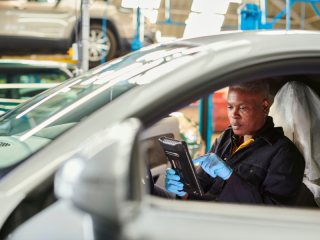
Commercial vehicles must meet specific vehicle inspection standards, so your fleet vehicles must undergo full vehicle inspections and maintenance regularly. Not only will this help to keep your drivers and other road users safe but can also prevent costly breakdowns.
By having proper procedures in place, businesses can reduce unplanned downtime and save time on fleet management.
In this guide, we’ve highlighted different types of vehicle inspections and provided a useful checklist detailing what to look out for during your daily walkaround check.
Types of inspections and checks
Pre-purchase inspection
Before purchasing any vehicle, it’s essential that you thoroughly check for any maintenance issues or defects as these could cause you endless problems in the long term if they go undetected. Some of the areas you should examine are:
Vehicle bodywork: Signs of major damage such as large dents and scratches can be evidence of a previous collision which could have resulted in a variety of unknown maintenance issues.
Chipped windows or windscreen: If chips to the windscreen or windows develop into cracks, businesses may be forced to pay for costly repairs or even a full replacement if necessary. This could also cause your vehicle to fail its MOT, keeping it off the road for longer and impacting your business financially.
Engine noises and fluid leaks: Before purchasing a vehicle, you should check that the engine is in good working order and isn’t making any unusual sounds or emitting any coloured smoke from the exhaust.
Registration and service history documents: Checking that all the details of your vehicle match the information on the V5C is essential, so you can ensure it has not been stolen. Finding out about the service history and previous MOT paperwork is always sensible as it gives you an indication of the vehicle’s performance and any prior maintenance issues.
For extra peace of mind, you could also seek professional advice by scheduling a pre-purchase inspection which will help you determine if the vehicle is mechanically and structurally sound.
Safety inspection
Businesses are responsible for the safety of their drivers, so it’s important that all fleet vehicles are routinely checked to make sure they meet minimum safety standards.
If your vehicles often travel long distances, then it might be necessary to conduct these safety inspections on a semi-regular basis. Some of the factors which will impact how often safety inspections should be carried out are:
The age and type of vehicle used
The recommendations of the vehicle manufacturer
The load and equipment of the vehicles
The terrain and environment where the vehicle operates
The distance and speeds at which the vehicle travels
Safety inspection intervals using range from 4 to 13 weeks and this is dependent on the operating conditions of the vehicle.
The recommended time frames for safety inspections are:
Operating conditions
Frequency
Lightly loaded vehicles – easy operating conditions
10-13 weeks
General haulage – trunking
6-10 weeks
Arduous work – constant heavy loads
4-6 weeks
Off-road – difficult conditions
4 weeks
Vehicle/trailer 12 years or older
6 weeks
However, if you have any concerns about the safety of your vehicles then you should conduct an immediate inspection or take it to a local garage to make sure there are no mechanical issues.
Daily walkaround check
In addition to regular safety inspections, HGV drivers are legally required to carry out daily walkaround checks, so that any faults or defects can be reported immediately. This will help to prevent maintenance issues from escalating and keep you and other road users safe.
The top 10 areas that drivers need to check are:
Mirrors, cameras, and glass – Look for any cracks, discolouration, or scratches and ensure that all mirrors are in place and not damaged or obscured.
Windscreen wipers and washers – Make sure they are undamaged and working correctly.
Dashboard warning lights – If there are any warning lights on display, investigate the issue immediately before setting off on your journey.
Brakes – Always ensure the footwell is clear and that the brakes are working correctly.
Lights and indicators – All lights and indicators must always be in working order and all lenses should be clean and the right colour.
Battery – Check that your battery is secure and not leaking.
Diesel exhaust fluid (AdBlue) – Ensure your vehicle has enough diesel and AdBlue, top it up if necessary.
Tyres – All tyres should have a tread depth of at least 1mm and tyres need to be secure, undamaged, and properly inflated.
Security of load – If you’re transporting a heavy load then you must use the correct load-securing system to ensure the load is secure and will not move en route.
Number plates – Your number plates should not be dirty or obstructed and you must display the UK identifier when driving a UK-registered vehicle abroad.
Vehicle inspections play a vital role in ensuring road safety and preventing accidents. Regular inspections can help identify potential issues before they become major problems, such as worn-out tyres, faulty brakes, or malfunctioning lights.
Inspections also ensure that your fleet vehicles are properly maintained, so they’ll last longer and be less likely to break down which can reduce costs and downtime for your business.
It’s important to record and report all inspections, as the DVSA can request proof that they’ve been regularly conducted during a roadside check. Also, if you notice defects whilst on the move, you should pull over as soon as it’s safe to do so and seek assistance if necessary.
Discover more top safety tips for HGV drivers.




